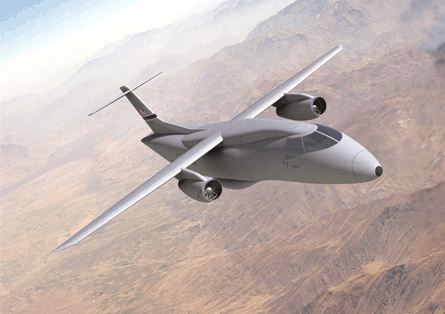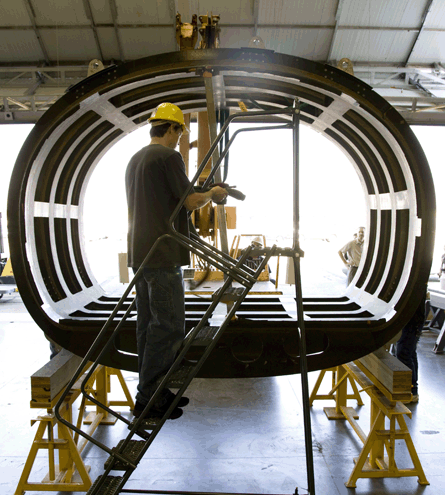When the latest X-plane crafted by Lockheed Martin's Skunk Works team soon takes flight over Palmdale, California, observers will be watching a throwback to a previous era of experimental flight technology, but also a potential harbinger of things still to come.
The Advanced Composite Cargo Aircraft (ACCA), a heavily modified Dornier 328JET, is expected to receive an XC-series designation by the US Air Force. It is perhaps the most significant airlifter project dedicated to experimenting with new technologies since the early 1970s, when the McDonnell Douglas YC-14 and Boeing YC-15 were flown.
The ACCA is also perhaps the first airlifter in the X-plane series since the LTV XC-142 tiltwing in 1964.
The fact that nearly four decades have passed since the last experimental airlifter project is more than a nostalgic memory. It is also a reminder. For within the US Department of Defense, there has been a recent revival of support for the kind of in-flight experimenting that made those earlier programmes possible.
 |
|---|
© Sgt Shannon Collins/USAF |
Indeed, the ACCA programme represents a growing vanguard of flying technology demonstrators starting to be funded by the US military's largest contributors to aerospace science - the Air Force Research Laboratory (AFRL) and the Defense Advanced Research Projects Agency.
Lockheed's Skunk Works team did not participate in the early XC-series demonstrations programmes, but it is certainly familiar with navigating experimental technologies into operational systems.
The YC-14 and the YC-15 were classed as prototypes duelling for a competitive contract, not an experimental demonstrator as the ACCA programme. But both prototypes were focused on proving different approaches to the problem of short take-off and landing of a heavy airlifter. MDC's approach eventually was rewarded with the C-17 contract.
The problem of lifting heavy payloads off short runways remains a major challenge for future military transports, but that is not the focus of the ACCA programme.
Instead, the ACCA programme was conceived to demonstrate a new type of airframe structure called out-of-autoclave (OOA) composites. According to programme officials, an airlift platform was selected primarily because the cargo mission presents the most stressing environment for structural components.
But, at the same time, both the AFRL and Lockheed are also looking ahead to the need to replace the C-130H fleet from around 2020 with potentially an all-new airframe, and launching an experimental demonstrator programme now presents an ideal timeline for being ready with an operational technology in another decade.
The potential for OOA technology, however, reaches far beyond the airlift community. The bonded airframe components could drive a new revolution in lightweight aircraft construction, potentially yielding benefits for the next generation of long-range strike aircraft.
Further, the manufacturing process itself for OOA technology could dramatically simplify the curing process for all-composite structures. If the concept is proven feasible and the technology matures, OOA materials could become the next technology push in the aerospace manufacturing sector.
ACCA DEFINED
The ACCA programme applied the Skunk Works model to developing and testing experimental aircraft, says Mike Swanson, Lockheed's programme manager. Key characteristics of this approach are:
- Skunks Works' team is kept small to shorten lines of communication.
- The customer is treated as part of the development team.
- The timeline for development is kept short, which reduces cost.
- Engineers work across the hall from assembly workers.
- Requirements are kept to a minimum and are not changed.
Instead of building an all-new demonstrator, Skunk Works searched for a low-cost demonstration vehicle that was representative of the aircraft size desired by the AFRL. Given the available budget and schedule, building an aircraft "from scratch" would have resulted in a much smaller aircraft, Swanson says.
The key goal for the ACCA programme was to incorporate out-of-autoclave composite materials in the main structure of the aircraft. Besides significant production systems benefits (see box), out-of-autoclave composite technology holds the promise of reducing the parts counts by a mathematical order of magnitude.
The key statistic involves the reduction of fasteners. The 328JET is assembled with 25,000 fasteners, but the modified ACCA platform will contain about 3,000, Swanson says. This weight savings would also lead to fuel cost reductions in operational aircraft.
 |
|---|
© David Henry |
The modified fuselage aft of the front section is bonded together in a low-temperature oven rather than mechanically fastened like aluminium structure. The length of the 17m (55ft)-long, 3m-wide, single-barrel fuselage is supported by only four structural frames, Swanson says.
Such OOA construction offers a major advance over even the Airbus A350 or Boeing 787 designs, which also rely on composite materials. Swanson likened the 787's construction to an aluminium airframe design, only with composite materials substituted for the previously metal structure.
The modified 328JET also corresponds to the AFRL's few fixed requirements for the ACCA platform: a high-wing jet, 400kt (740km/h) cruise speed and a payload that can accommodate a 463L cargo pallet, Swanson says.
Those requirements "pointed to only one configuration that could support it", says Swanson, referring to the 328JET.
The modifications include a widened ramp area to support loading of up to two 463L pallets, plus additional cargo payload on the ramp itself, Swanson says.
The modifications, which included a widened fuselage and an elevated high-wing, also required Skunk Works to design an all-new vertical tail.
The original forward fuselage, including all major avionics and cockpit equipment, remain intact.
When the aircraft was shown to a visiting journalist inside the hangar in late March, the fuselage adaptations were nearly completed and the airframe was about one week away from a trip to the paintshop, Swanson says.
FLIGHT TEST
For the ACCA programme, the first flight scheduled in June marks the end of the graduation exercise for AFRL's currently funded project. The single-flight event will come after the aircraft clears a series of technical review boards managed by the Air Force Flight Test Center at Edwards AFB. Although the flight is scheduled in June, programme officials are careful to note that the aircraft will fly only when it is ready.
Completing the first flight will close the second phase of the ACCA demonstrator programme, with the first phase involving the initial concept and design work.
A follow-on third phase is expected to launch immediately after first flight, says Barth Schenk, ??. The third phase will fund a series of envelope expansion flights. The length will depend on the available funding.
The initial plan was to stage a year-long series of increasingly sophisticated aerial manoeuvres, but the timeline could be scaled back depending on how fast the programme spends its allotted funding, Schenk says.
With Phase 3 scheduled to expire by mid-2010, AFRL and Skunks Works managers are already considering options for the ACCA platform's long-term future.
The aerospace community has an increasing need for testbed platforms to check out sensor payloads in flight. Experimental aircraft such as the ACCA platform are often prime candidates for such roles once their initial flight tests have been completed.
Not surprisingly, the ACCA programme has already started advertising its services within the experimental testbed market. The aircraft's key attributes, including two-pallet volume, 1,814kg payload capacity, and 4h endurance, could make it an attractive option for sensor experiments, Schenk says.
COMPOSITE RESIN IS THE KEY TO ACCA
THE MOST important thing about Skunk Works' latest X-plane - the Advanced Composite Cargo Aircraft (ACCA) - is its raw material. The fact that ACCA is a cargo aircraft is secondary. The modified Dornier 328JET is really a flying laboratory for a new type of out-of-autoclave composite material, specifically called MTM45-1.
Unlike other composites resins, MTM45-1 is not cured in an autoclave. This fact alone qualifies the resin as a potential "disruptive technology" in the aerospace manufacturing sector.
For background, small piece-parts have been cured outside of autoclaves for more than a decade. But larger structures, such as the all-composite fuselage "barrels" that comprise the Boeing 787, still require the higher pressure and temperature provided by autoclaves to acquire the necessary strength.
All aircraft structures must demonstrate a compression after impact strength of at least 28.12kg/mm2 (40,000lb/in2). The Toray 3900-2 resin which forms the 787's composite barrels is cured in high-pressure autoclave chambers and meets the standard, says Yeow Ng, associate director at the National Center for Advanced Materials Performance in Wichita.
But autoclaves come at a high price. First, there is the non-recurring investment to build the huge ovens. Another major cost is the expendable stock of nitrogen gas to heat the autoclave chambers.
Smaller structures are already produced outside autoclaves. The common process is to layer strips of resin into a mould, which is sealed and a vacuum pump used to exert pressure. That force bonds the layers of resins into a single component. However, even the world's best vacuum pumps exert only a fraction of the pressure produced by autoclaves, says Ng. With less pressure applied, the finished composite structure is inherently weaker than autoclave-cured pieces. So the vacuum-assisted resin transfer moulding process is mostly limited to smaller components or non-commercial aircraft structures.
A more effective solution - but far more challenging - would be to develop more advanced resins. The aim would be to formulate a new kind of resin that can be shaped as hard as autoclave-cured structures, but requires about half the amount of heat applied.
Finding the right formula could make a huge impact on the manufacturing process. By removing the need for autoclaves, airframers could eliminate a source of inefficiency and high cost.
For new aircraft production systems, there would be no need to build and fuel huge autoclave chambers where large composite structures are assembled. Special, heat-resistant tooling used to put structures inside the autoclaves would also become redundant.
Also, structures could be cured in special ovens with temperatures ranging from 150-180°F (65.5-82.2°C). It may even be possible to construct low-temperature ovens directly into the regular production flow, avoiding the disruption caused by moving structures from the autoclave to the next stage of assembly.
The trick is to develop such resins that can be cured at relatively low temperatures and retain the strength characteristics of structures pressurised in autoclaves.
MTM45-1 is considered a giant step forward in the march toward the next generation of out-of-autoclave materials, says Ng.
Its composite resins are bolstered with a "toughening agent", says Mike Swanson, Lockheed Martin's ACCA programme manager. This agent helps to compensate for the lack of high pressures and temperatures used by autoclaves during the curing process.
The material is expected to be strong enough to qualify as safe to use for experimental aircraft programmes.
Before it was adopted by the ACCA programme, the MTM45-1 resin was incorporated in the Scaled Composites White Knight 2 aircraft. Skunk Works also has experience using such composite material for the P175 Polecat unmanned air vehicle, which was destroyed in a crash.
Swanson says the ACCA composite materials are comparable in performance to autoclave-cured resins. But the data suggests MTM45-1 still falls short of today's most advanced composite technology used in commercial aircraft production, says Ng.
Although MTM45-1 will continue to have value in experimental and technically ambitious programmes, it falls short of qualifying for the strength tolerances demanded by regulators for commercial airliners. The 787 structure's compression after impact strength level measures in the mid-40s kip/in2, but MTM45-1 falls somewhere in the mid-30 kip/in2 range, says Ng.
Until a resin formula produces a comparable strength level as 787-like composite materials, OOA structures will be restricted to projects such as ACCA and Polecat.
It could be several years before composite material technology is able to support OOA strength requirements for commercial aircraft regulators. As aerospace manufacturers are typically conservative about adopting new technology, the timeline could stretch even longer.
But that expectation does not diminish the importance of the involvement of MTM45-1 in the ACCA programme. As an experimental aircraft, it should yield badly needed data about the behaviour of the composite materials in service.
Source: Flight Daily News
















